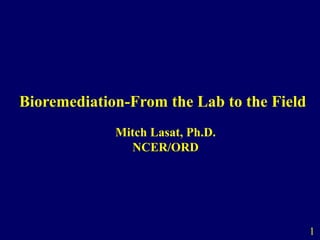
20060309.ppt
- 1. Bioremediation-From the Lab to the Field Mitch Lasat, Ph.D. NCER/ORD 1
- 2. •What is Bioremediation? •Why Bioremediation works? •Contaminants amenable to Bioremediation •Limiting factors (why bioremediation doesn’t work?) •Engineering strategies for Bioremediation •Is bioremediation a “hot” research topic for the EPA? •Bioremediation research 2 Presentation Outline
- 3. What is Bioremediation? the use of biota to degrade/mitigate environmental contamination -bioremediation- by microorganisms (soil, groundwater-organic contaminants) -phytoremediation- by plants (mostly soil and surface water) 3
- 4. Why Bioremediation works? microorganisms obtain energy for growth by degrading organic contaminants in an enzyme-mediated process- direct metabolism -aerobic biodegradation of BTEX in the presence of an oxygenase (Pseudomonas) some enzymes are not very specific and in addition to the growth substrate transform other compounds-cometabolism -oxygenases are not very substrate-specific and can also degrade TCE (however TCE cannot be used as a growth substrate) 4
- 5. Contaminants amenable to Bioremediation I Hydrocarbons: - BTEX (aerobic and anaerobic biodegradation) - PAH (less amenable) - aerobic degradation via cometabolism - anaerobic biodegradation (naphtalene-denitrification) Chlorinated Aliphatic Hydrocarbons - aerobic electron donor (DCM, CM, DCA) - anaerobic electron donor (TCE, DCE) - anaerobic acceptor (PCE, TCE)- dehalorespiration - cometabolism (aerobic, anaerobic-reductive dechlorination) Chlorinated aromatic hydrocarbons - PCB (in general bioremediation recalcitrant) -aerobic, less chlorinated -anaerobic (dehalorespiration) - PCP; aerobic, anaerobic (groundwater-reductive dechlorination) - Dioxins; highly resistant to Bioremediation 5
- 6. Contaminants amenable to Bioremediation II Pesticides -chlorinated; highly resistant to aerobic transformation -phosphorus based and carbamate; quickly hydrolyzed -triazine; biodegradable Explosives -biotransformation is partial (TNT) or slow (RDX) Inorganics -bacterial reduction of Hg2+ to Hg0 -bacterial reduction of Cr6+ to Cr3+ 6
- 7. Factors that limit the potential for Bioremediation (why Bioremediation doesn’t work) 1) Contaminant-related limitations: Synthetic vs. natural contaminants -bioremediation potential greater for natural compounds Physical characteristics -density, Henry’s constant, solubility, octanol/water partition coefficient Molecular structure of the contaminant -extent of chlorination, linear vs. branched structure, saturated vs. unsaturated compounds 7
- 8. Factors that limit the potential for Bioremediation (why Bioremediation doesn’t work) 2) Environmental conditions: Hydrogeology: permeability/hydraulic conductivity, heterogeneity, fracture bed rocks, soil properties, pH Nutrients: C:N:P-100:10:1 Electron acceptor: oxygen (3 parts of oxygen to converts 1 part of hydrocarbon to CO2), nitrate, sulfate, ferric iron 3) Microorganisms presence: Assessment of microbial activity, introduced microorganisms 8
- 9. Engineering Strategies for Bioremediation Intrinsic bioremediation/natural attenuation Enhanced/engineered bioremediation -addition of nutrients, oxygen Bioaugmentation -introduction of appropriate organisms 9
- 10. Phytoremediation 10 Phytoextraction (removal/extraction of toxic metals- Pb) Phytodegradation (organics degradation in roots and shoots- TPH, PAHs, BTEX, pesticides, CAHs) Phytovolatilization (CAHs, Hg, Se) Evapotranspiration/Hydraulic control (plume reduction)
- 11. Is bioremediation a “hot” research topic for the EPA? 11 Cross-agency research advisory workgroup for Goal 3; Bioremediation- a priority technology for remediation of contaminated sediments, groundwater and soil ORD GOAL 3 MYP-long-term goal oriented with annual progress measured by completion of APG/APM-of the approximately 70 remediation-related APMs, approximately half pertain to bioremediation: - Report on biodegradation of PAHs in sediments - Report on solvent-enhanced residual biotreatment of residual DNAPL - Develop and evaluate microbial populations for effective TCE biodegradation - Develop and evaluate cost-effective methods for nutrient mixing and delivery for bioremediation of chlorinated aliphatic hydrocarbons - Synthesis report on 5 DNAPL remediation technologies
- 12. •Bioremediation research I 12 ORD’s Goal 3research program is designed to provide a better understanding of the traditional risk management options (dredging, capping, pump and treat), and to investigate alternative options (bioremediation, MNA) Problem-driven research program, supporting research needs of: - Office of Solid Waste - Superfund - Leaking Underground Storage Tank Corrective Action - Oil Spills Contacts: NPD-Randy Wentsel NRMRL-Trish Erickson NCER-Mitch Lasat
- 13. 13 NCER Bioremediation research: - 1997-2001; several RFAs on Bioremediation and Phytoremediation - 2001; HSRC program was recompeted, research focus on contaminated sediments, VOC-contaminated groundwater, mine wastes, phytoremediation http://es.epa.gov/ncer/grants/ Case studies/performance data: http://clu-in.org/techfocus/ - site general information - contaminants - site hydrology - media - cleanup goals - technology used - results/costs - lessons learned •Bioremediation research II